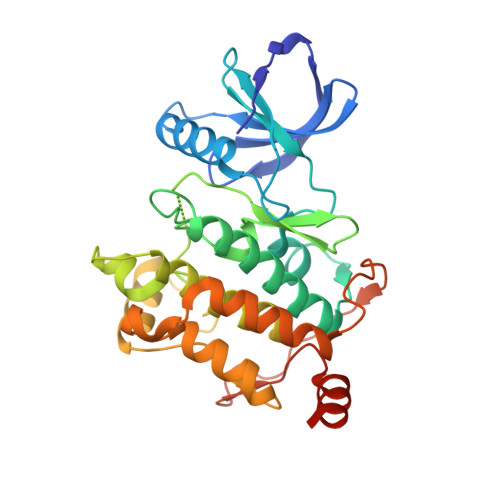Discovery of a potent and highly selective transforming growth factor beta receptor-associated kinase 1 (TAK1) inhibitor by structure based drug design (SBDD)
Muraoka, T., Ide, M., Morikami, K., Irie, M., Nakamura, M., Miura, T., Kamikawa, T., Nishihara, M., Kashiwagi, H.(2016) Bioorg Med Chem 24: 4206-4217
- PubMed: 27448772
- DOI: https://doi.org/10.1016/j.bmc.2016.07.006
- Primary Citation of Related Structures:
5JGA, 5JGB, 5JGD - PubMed Abstract:
A novel thienopyrimidinone analog was discovered as a potent and highly selective TAK1 inhibitor using the SBDD approach. TAK1 plays a key role in inflammatory and immune signaling, so TAK1 is considered to be an attractive molecular target for the treatment of human diseases (inflammatory disease, cancer, etc.). After the hit compound had been obtained, our modifications successfully increased TAK1 inhibitory activity and solubility, but metabolic stability was still unsatisfactory. To improve metabolic stability, we conducted metabolic identification. Although the obtained metabolite was fortunately a potent TAK1 inhibitor, its kinase selectivity was low. Subsequently, to achieve high kinase selectivity, we used SBDD to follow two strategies: one targeting unique amino acid residues in TAK1, especially the combination of Ser111 and Asn114; the other decreasing the interaction with Tyr106 at the hinge position in TAK1. As expected, our designed compound showed an excellent kinase selectivity profile in both an in-house and a commercially available panel assay of over 420 kinases and also retained its potent TAK1 inhibitory activity (TAK1 IC50=11nM).
Organizational Affiliation:
Research Division, Chugai Pharmaceutical Co,. Ltd, 1-135 Komakado, Gotemba, Shizuoka 412-8513, Japan. Electronic address: muraokatrs@chugai-pharm.co.jp.















